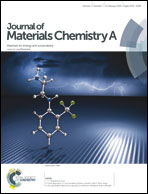The unique synthesis and energetic properties of a novel fused heterocycle: 7-nitro-4-oxo-4,8-dihydro-[1,2,4]triazolo[5,1-d][1,2,3,5]tetrazine 2-oxide and its energetic salts†
Abstract
The unique and facile synthesis of 7-nitro-4-oxo-4,8-dihydro-[1,2,4]triazolo[5,1-d][1,2,3,5]tetrazine 2-oxide (HBCM) and a proposed mechanism for its formation are described. The hygroscopicity of HBCM was overcome by transforming it into salts. The energetic salts of HBCM were characterized by 1H and 13C nuclear magnetic resonance spectroscopy, infrared spectroscopy, differential scanning calorimetry (DSC) and elemental analysis. The crystal structures of the sodium and guanidinium salts were determined by single-crystal X-ray diffraction. The densities of the salts ranged from 1.77 to 1.97 g cm−3. Most of the energetic salts decomposed above 230 °C and tended to be insensitive to impact, friction and electrostatic discharge. Theoretical performance calculations (Gaussian 03 and EXPLO5) for the energetic salts provide detonation pressures and velocities within the ranges of 25.2 to 39.5 GPa and 7856 to 9069 m s−1, respectively. The hydroxylammonium salt showed high density (1.97 g cm−3), acceptable decomposition temperature (Td = 197 °C), low sensitivities, and excellent detonation velocity (9069 m s−1) and pressure (39.5 GPa), which suggests that it has the potential to be used as a high-energy-density material.
![Graphical abstract: The unique synthesis and energetic properties of a novel fused heterocycle: 7-nitro-4-oxo-4,8-dihydro-[1,2,4]triazolo[5,1-d][1,2,3,5]tetrazine 2-oxide and its energetic salts](/en/Image/Get?imageInfo.ImageType=GA&imageInfo.ImageIdentifier.ManuscriptID=C4TA06139J&imageInfo.ImageIdentifier.Year=2015)

 Please wait while we load your content...
Please wait while we load your content...